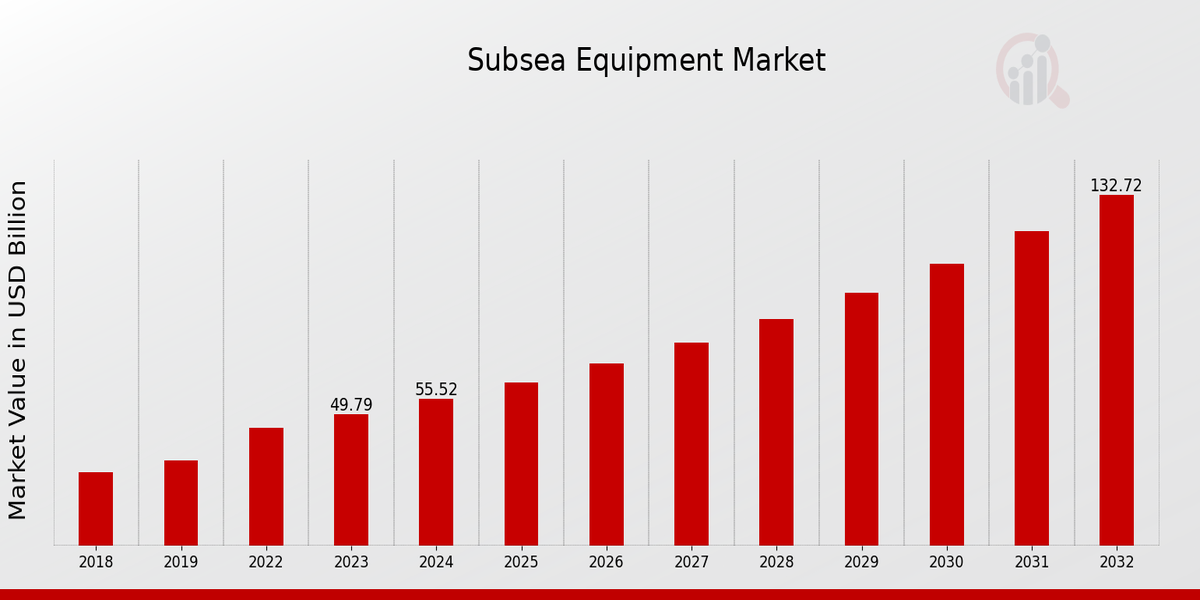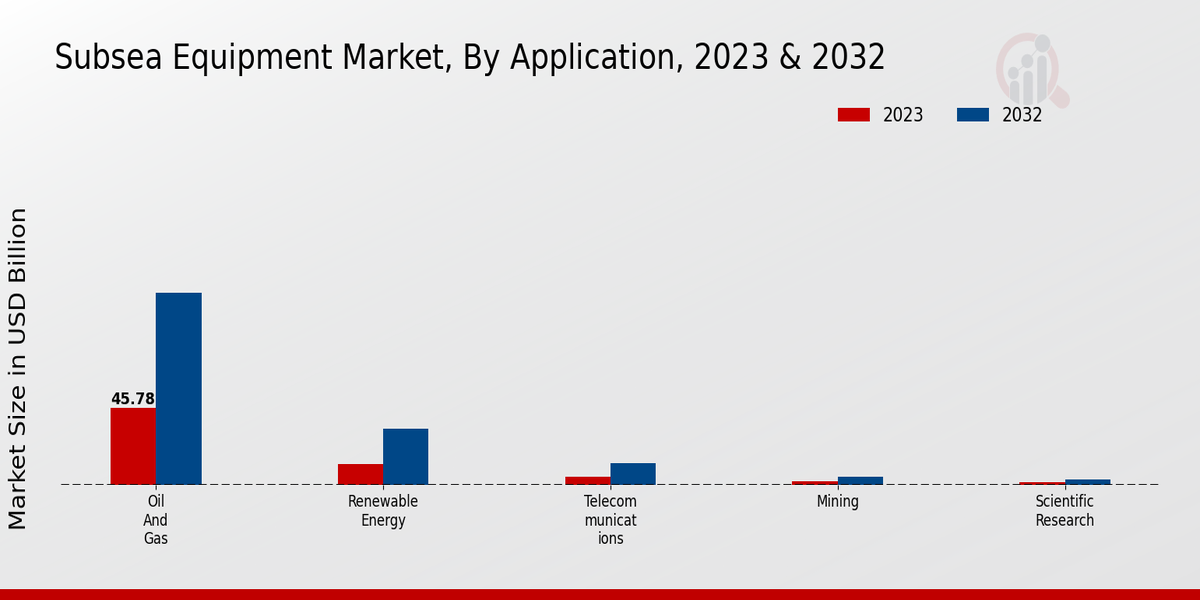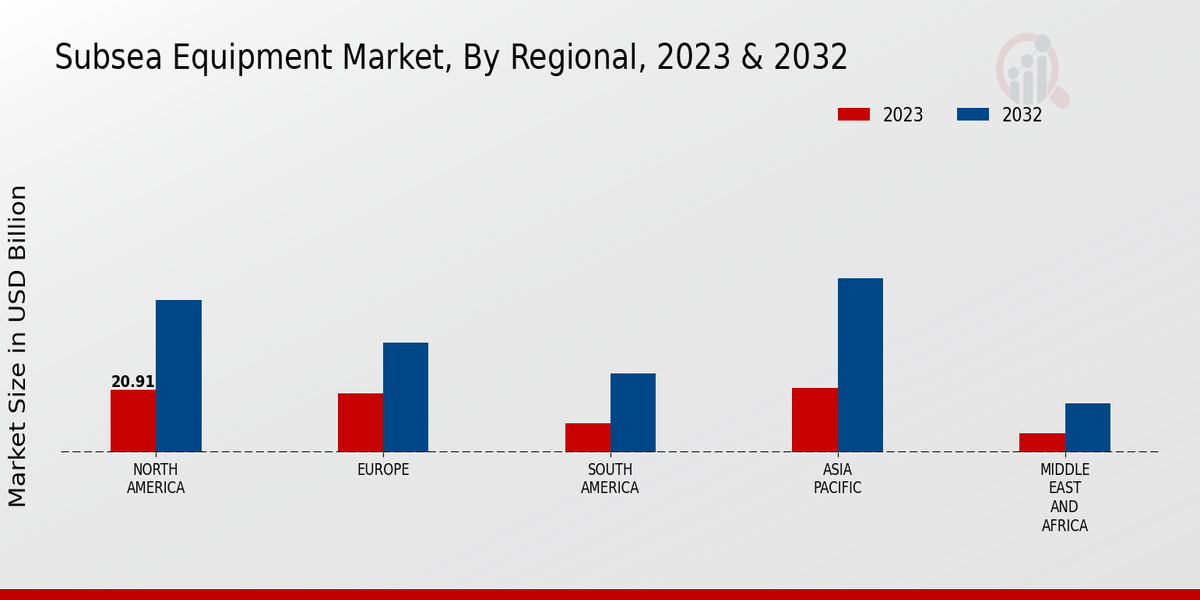Global Subsea Equipment Market Overview:
As per MRFR analysis, the Subsea Equipment Market Size was estimated at 61.91 (USD Billion) in 2024. The Subsea Equipment Market Industry is expected to grow from 69.04 (USD Billion) in 2025 to 184.08 (USD Billion) till 2034, at a CAGR (growth rate) is expected to be around 11.51% during the forecast period (2025 - 2034).
Key Subsea Equipment Market Trends Highlighted
Technological growth can be identified as one of the key trends in the Subsea Equipment Market, particularly in the case of utilizing autonomous underwater vehicles (AUVs) and remotely operated vehicles (ROVs), enabling more effective search and repairs of the subsea area. Moreover, this industry also experiences a transition towards digitalization with increased application of data analytics and machine learning for better operational efficiency of subsea assets. Other factors driving the market are the increasing propensity to focus on the surroundings, which encourages the creation of cleaner subsea equipment and the use of green energy. Also, partnerships between the players in the sector and research establishments enhance inventiveness, and help in finding new activities within the subsea industry.

Source: Primary Research, Secondary Research, MRFR Database and Analyst Review
Subsea Equipment Market Drivers
Increasing demand for offshore oil and gas exploration and production
The increasing demand for energy globally is driving the growth of the offshore oil and gas industry. As onshore reserves become depleted, companies are increasingly looking to offshore sources to meet their production needs. This is leading to a rise in the demand for subsea equipment, which is used in the exploration, development, and production of offshore oil and gas reserves. The Subsea Equipment Market Industry is expected to grow significantly in the coming years, driven by the increasing demand for offshore oil and gas exploration and production.The market is expected to witness a CAGR of 11.51% during the forecast period from 2023 to 2032. Subsea equipment is essential for the safe and efficient exploration and production of offshore oil and gas. It includes a wide range of equipment, such as subsea production systems, subsea umbilicals, risers, and flowlines. These systems are used to extract oil and gas from subsea reservoirs and transport it to surface facilities. The increasing demand for offshore oil and gas is also driving the development of new and innovative subsea equipment.Companies are investing in research and development to improve the efficiency and safety of their subsea operations. This is leading to the development of new technologies, such as remotely operated vehicles (ROVs), autonomous underwater vehicles (AUVs), and subsea processing systems. These new technologies are helping to reduce the costs and risks associated with offshore oil and gas production. They are also enabling companies to explore and produce oil and gas from deeper and more challenging environments. The increasing demand for offshore oil and gas exploration and production is expected to continue to drive the growth of the Subsea Equipment Market Industry in the coming years.
Technological advancements
The Subsea Equipment Market Industry is also being driven by technological advancements. The development of new technologies is helping to improve the efficiency and safety of subsea operations. One of the most significant technological advancements in recent years is the development of remotely operated vehicles (ROVs). ROVs are unmanned underwater vehicles that can be used to perform a variety of tasks, such as inspection, maintenance, and repair.ROVs are increasingly being used in offshore oil and gas operations, as they can help to reduce the risks and costs associated with human intervention. Another important technological advancement is the development of autonomous underwater vehicles (AUVs). AUVs are unmanned underwater vehicles that can operate without human intervention. AUVs are being used in a variety of applications, such as seabed mapping, pipeline inspection, and environmental monitoring. The development of new technologies is helping to make offshore oil and gas production safer and more efficient.This is leading to increased demand for subsea equipment as companies look to adopt the latest technologies to improve their operations.
Government regulations
Government regulations are also playing a role in the growth of the Subsea Equipment Market Industry. Governments around the world are increasingly implementing regulations to protect the environment and ensure the safety of offshore oil and gas operations. These regulations are driving demand for subsea equipment that can help companies comply with environmental and safety standards. For example, governments are increasingly requiring companies to use subsea equipment that can minimize the risk of oil spills and other environmental accidents. Government regulations are also driving demand for subsea equipment that can help companies improve the safety of their offshore operations.For example, governments are increasingly requiring companies to use subsea equipment that can help prevent accidents and injuries. The increasing stringency of government regulations is expected to continue to drive the growth of the Subsea Equipment Market Industry in the coming years.
Subsea Equipment Market Segment Insights:
Subsea Equipment Market Application Insights
The Subsea Equipment Market is segmented by application into various segments such as oil and gas, renewable energy, telecommunications, mining, and scientific research. The oil and gas segment is expected to hold the largest share in 2023, accounting for over two-thirds of the global market revenue. This dominance is due to the rising demand for subsea equipment in deepwater oil and gas exploration and production activities. The renewable energy segment is anticipated to witness significant growth in the coming years, owing to increasing investments in offshore wind farms and tidal energy projects.The telecommunications segment also holds a prominent share of the market and is projected to grow steadily during the forecast period, driven by expanding subsea cable infrastructure for data transmission. The mining segment has a smaller market share but is anticipated to witness growth in the future due to increasing deep-sea mining activities. The scientific research segment is expected to have a moderate market share and is driven by government-funded research initiatives in oceanography and climate science. Overall, the Subsea Equipment Market is poised for robust growth in the coming years, with steady contributions from various application segments.

Source: Primary Research, Secondary Research, MRFR Database and Analyst Review
Subsea Equipment Market Depth of Water Insights
The Subsea Equipment Market is segmented based on the Depth of Water into Shallow Water (0-500 meters), Deep Water (500-1,500 meters), and Ultra-Deep Water (1,500 meters and below). The Deep Water segment is projected to lead the market in terms of revenue, contributing around 42.3% of the total market share in 2023. The growth of this segment can be attributed to the increasing exploration and production activities in deepwater regions, particularly in offshore Brazil, the Gulf of Mexico, and West Africa. The Shallow Water segment is expected to witness a moderate growth rate over the forecast period due to the increasing demand for subsea equipment in shallow water regions, such as the North Sea, Caspian Sea, and Southeast Asia.The Ultra-Deep Water segment is anticipated to grow at a significant pace, driven by technological advancements and increasing investments in deepwater exploration and production projects.
Subsea Equipment Market System Type Insights
The Subsea Equipment Market segmentation by System Type includes Subsea Production Systems, Subsea Drilling Systems, Subsea Processing Systems, Subsea Controls and Communication Systems, and Subsea Inspection, Maintenance, and Repair (IMR) Systems. Subsea Production Systems held the largest market share in 2023, and it is expected to continue to dominate the market throughout the forecast period. The growth of this segment can be attributed to the increasing demand for subsea production systems in deepwater and ultra-deepwater environments.The Subsea Drilling Systems segment is anticipated to witness significant growth over the forecast period due to the rising demand for drilling in deepwater and ultra-deepwater regions. The growing need for efficient and cost-effective subsea processing systems is driving the growth of the Subsea Processing Systems segment. The Subsea Controls and Communication Systems segment is also expected to grow steadily over the forecast period due to the increasing adoption of subsea control systems for remote monitoring and operation of subsea equipment. The Subsea Inspection, Maintenance, and Repair (IMR) Systems segment is expected to grow at a steady pace due to the rising demand for IMR services for subsea assets.
Subsea Equipment Market Product Type Insights
The Subsea Equipment Market is segmented by product type into Subsea Trees, Subsea Wellheads, Subsea Manifolds, Subsea Pipelines and Risers, Subsea Control Modules, Subsea Sensors and Instruments, and Subsea Umbilicals and Cables. Among these segments, Subsea Trees and Subsea Wellheads are expected to hold significant market shares in 2023, owing to their critical role in regulating and controlling the flow of fluids in subsea production systems. The increasing number of deepwater and ultra-deepwater exploration and production projects is driving the demand for these components.This growth is attributed to the increasing investments in offshore oil and gas exploration and production activities, technological advancements in subsea equipment, and the growing demand for subsea equipment for deepwater and ultra-deepwater projects.
Subsea Equipment Market Regional Insights
The Subsea Equipment Market is expected to reach a value of USD 56.7 billion by 2024, exhibiting a CAGR of 11.2% during the forecast period. Regionally, North America is anticipated to hold the largest market share, owing to the presence of major oil and gas companies and increasing offshore exploration activities. Europe is another significant market driven by stringent environmental regulations and the need for subsea infrastructure upgrades. APAC is expected to witness substantial growth due to rising investments in offshore oil and gas projects, particularly in countries like China and India.South America and MEA are emerging markets with potential growth opportunities supported by increasing exploration and production activities.

Source: Primary Research, Secondary Research, MRFR Database and Analyst Review
Subsea Equipment Market Key Players And Competitive Insights:
Major players in the Subsea Equipment Market industry are constantly striving to develop innovative technologies and expand their product portfolios. Through strategic partnerships and acquisitions, leading Subsea Equipment Market players are aiming to enhance their capabilities and gain a competitive edge. Growing investments in offshore oil and gas exploration and production are propelling the demand for advanced subsea equipment, driving market development. The Subsea Equipment Market Competitive Landscape is characterized by a mix of established industry leaders and emerging players.Aker Solutions, a prominent player in the Subsea Equipment Market, offers a comprehensive suite of products and services, including subsea production systems, umbilicals, and riser systems. The company has a strong global presence and a proven track record of delivering innovative solutions to meet the evolving needs of the offshore industry. Aker Solutions' commitment to research and development, combined with its extensive experience, has positioned it as a leading provider of subsea equipment.FMC Technologies is another key player in the Subsea Equipment Market. The company specializes in the design, manufacture, and supply of subsea systems and equipment for the oil and gas industry. FMC Technologies' portfolio includes subsea trees, manifolds, and control systems. The company's focus on providing reliable and efficient solutions has earned it a reputation as a trusted supplier to major oil and gas operators. FMC Technologies' global presence and commitment to innovation have contributed to its strong position in the market.
Key Companies in the Subsea Equipment Market Include:
Subsea Equipment Market Industry Developments
The Subsea Equipment Market is anticipated to reach a value of USD 184.08 billion by 2034, expanding at a CAGR of 11.51% from 2025 to 2034. Increasing offshore oil and gas exploration and production activities, coupled with the growing need for subsea infrastructure to support deepwater operations, are driving market growth. Technological advancements, such as the development of remotely operated vehicles (ROVs) and autonomous underwater vehicles (AUVs), are also contributing to market expansion. Additionally, government initiatives to promote subsea exploration and development are expected to further stimulate market growth in the coming years. Recent developments include investments in subsea robotics and data analytics to enhance operational efficiency and safety. Furthermore, the increasing adoption of digital twins and virtual reality technologies is expected to revolutionize the subsea equipment market in the near future.
Subsea Equipment Market Segmentation Insights
Subsea Equipment Market Application Outlook
- Oil and Gas
- Renewable Energy
- Telecommunications
- Mining
- Scientific Research
Subsea Equipment Market Depth of Water Outlook
- Shallow Water (0-500 meters)
- Deep Water (500-1,500 meters)
- Ultra-Deep Water (1,500 meters and below)
Subsea Equipment Market System Type Outlook
- Subsea Production Systems
- Subsea Drilling Systems
- Subsea Processing Systems
- Subsea Controls and Communication Systems
- Subsea Inspection, Maintenance and Repair (IMR) Systems
Subsea Equipment Market Product Type Outlook
- Subsea Trees
- Subsea Wellheads
- Subsea Manifolds
- Subsea Pipelines and Risers
- Subsea Control Modules
- Subsea Sensors and Instruments
- Subsea Umbilicals and Cables
Subsea Equipment Market Regional Outlook
- North America
- Europe
- South America
- Asia Pacific
- Middle East and Africa
| Report Attribute/Metric |
Details |
|
Market Size 2024
|
61.91 (USD Billion)
|
|
Market Size 2025
|
69.04 (USD Billion)
|
|
Market Size 2034
|
184.08 (USD Billion)
|
|
Compound Annual Growth Rate (CAGR)
|
11.51% (2025 - 2034)
|
|
Report Coverage
|
Revenue Forecast, Competitive Landscape, Growth Factors, and Trends
|
|
Base Year
|
2024
|
|
Market Forecast Period
|
2025 - 2034
|
|
Historical Data
|
2019 - 2023
|
| Market Forecast Units |
USD Billion |
| Key Companies Profiled |
Chevron |
| Segments Covered |
Application, Depth of Water, System Type, Product Type, Regional |
| Key Market Opportunities |
Growing offshore wind market Increasing subsea oil and gas exploration Technological advancements Rising demand for subsea cables Expanding marine infrastructure. |
| Key Market Dynamics |
Increased offshore oil and gas exploration Technological advancements Growing demand for deepwater exploration Government initiatives and regulations Rising environmental concerns |
| Countries Covered |
North America, Europe, APAC, South America, MEA |
Frequently Asked Questions (FAQ) :
The Subsea Equipment Market is estimated to be valued at USD 69.04 billion in 2025.
The Subsea Equipment Market is projected to grow at a CAGR of 11.51% from 2025 to 2034.
North America is expected to hold the largest market share in the Subsea Equipment Market in 2023.
The oil and gas segment is expected to account for the largest share of the Subsea Equipment Market in 2023.
Some of the key competitors in the Subsea Equipment Market include Aker Solutions, FMC Technologies, GE Oil & Gas, Halliburton, and Schlumberger.
The key growth drivers of the Subsea Equipment Market include increasing demand for oil and gas, growing offshore exploration and production activities, and technological advancements.
The key challenges faced by the Subsea Equipment Market include high costs, harsh operating conditions, and environmental concerns.
The emerging trends in the Subsea Equipment Market include the use of robotics, automation, and digital technologies.
Government regulations play a significant role in the Subsea Equipment Market, as they impact safety, environmental protection, and market competition.
The future prospects of the Subsea Equipment Market are positive, driven by increasing oil and gas demand, technological advancements, and growing offshore exploration and production activities.

















